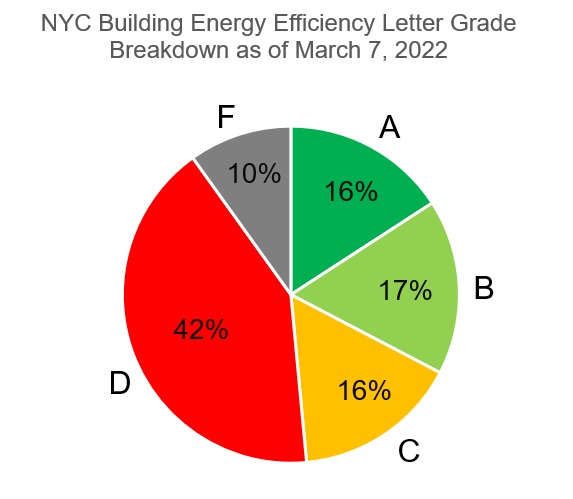

Blog
Get answers to all your questions about New York City’s Building Energy Efficiency Rating Labels and letter grades from our energy experts.

New York City buildings over 25,000 square feet must display a Building Energy Efficiency Rating Label, as required by Local Law 33 of 2018 and Local Law 95 of 2019.
Each year, buildings are given new energy efficiency grades based on benchmarking data from the previous calendar year.
New labels are available to building owners every year on October 1. Labels must be downloaded and posted in the lobby of each building by October 31. Failure to display the label by this deadline will result in a violation from the Department of Buildings and fine of $1,250 for applicable buildings.
Keep reading to get answers to all your questions about New York City’s building energy efficiency letter grades and labels from our energy experts.
This blog post was originally published on October 20, 2020. It was updated in May 2023 with the latest information on NYC’s building energy efficiency labels.

The label requirement applies to buildings 25,000 square feet and greater. These are the same buildings covered by New York City’s energy benchmarking laws and the carbon fine law.
Owners of properties that are listed on the Covered Buildings List for benchmarking compliance, as per Department of Finance records, are required to comply. The Covered Buildings List is updated annually.
Temporary exemptions are available for properties undergoing ownership changes and properties undergoing construction or demolition with no temporary certificate of occupancy (TCO) in the applicable reporting year. Properties that are exempt or not eligible for an ENERGY STAR score will receive an “N” grade and will not be subject to the label requirement. More information on ENERGY STAR score eligibility can be found here.
Letter grades are based on energy usage. They are updated annually and reported to the City of New York during Local Law 84 energy benchmarking compliance.
Letter grades are given based on a property’s ENERGY STAR score, which is a metric calculated during energy benchmarking. The ENERGY STAR score ranges from 1-100, with higher scores representing better energy performance.
The score considers multiple operational factors but is largely based on Source Energy Use Intensity (EUI) [PDF]. Source EUI is a measure of the annual energy used on site at a property—electricity, gas, fuel oil, district steam—plus the amount of energy required to generate, transmit, and distribute that energy to the site.
Source EUI is negatively impacted by electricity usage; it’s weighted nearly three times more than the use of gas or fuel oil, which is counter-intuitive during a time when the industry is pushing towards electrification. This is due to the additional energy required to produce and deliver electricity to a building.
If you are the owner or manager of an electrically heated building and you have a low grade, you’re not alone. Keep reading for steps to improve your grade.
The ENERGY STAR score is mapped to letter grades using the following scale:

In 2021, over half of NYC buildings received C or D grades.
ENERGY STAR scores are meant to be distributed evenly across the 1-100 spectrum, with 50 as the national median. New York City buildings are rated slightly better than the national average, with a median of about 60—although there are a lot of low-scoring buildings.
A low grade is frustrating, but it’s important to remember that one purpose of this law is to spur action towards energy efficiency upgrades.

Missing or misrepresented information can lead to incorrect ENERGY STAR scores. The most important data points to verify are floor areas, property use types (e.g., separately reporting a ground-floor retail space in a multifamily building), and operational details.
For multifamily properties, verify the number of units and number of bedrooms. For commercial offices, verify the operating hours, number of workers, and the number of computers for each individual tenant.
We are still clarifying with the Department of Buildings how to correct errors in the energy data, and whether a new label can be generated before the next year’s deadline. Stay tuned for updates.
If you have a building engineer, operator, or superintendent on site, discuss how the current systems are operating and if there are ways to save energy. There may be training opportunities for your building staff to improve performance.
Depending on staff experience, it may be beneficial to hire an outside consultant to perform an energy audit of your building systems. This study can provide you with an inventory of your systems and an assessment for ways to reduce energy usage and save money with a combination of operational and capital improvements.
The relationship between energy letter grades and carbon fines can be confusing, as they are based on different metrics. There is some overlap in energy letter grades and carbon fines, but it is possible to face potential carbon fines even with A grades and no fines with D grades.
Carbon fines are determined by Local Law 97 of 2019, which is one piece of the New York City Climate Mobilization Act.
The same group of buildings required to comply with energy benchmarking and energy letter grades are assigned carbon emission targets based on property type. Starting in 2024, buildings will be fined on an annual basis if they exceed their targets, which then become more stringent about every five years.
Based on New York City building performance in 2019, approximately 20% of buildings exceed the 2024-2029 targets, while approximately 75% of buildings exceed the 2030-2034 targets, according to the City Council’s press release.
The carbon fines are based on a property’s annual energy usage, accounting for the carbon intensity of each fuel type, with an ultimate goal of moving away from fossil fuels altogether.
“Dirtier” fuels, such as #2 and #4 fuel oil, emit more carbon than natural gas. The carbon intensity of today’s electric grid is comparable to that of fossil fuels, but New York State climate goals are pushing towards a cleaner grid, with an aim to be carbon neutral by 2040.
It still makes sense to consider electrification projects, especially with next-generation technology such as heat pumps that can increase heating efficiency significantly beyond what even the best combustion systems can provide.
Want to learn more about electrification? Enroll in the Building Electrification Training Series on SWA Academy here.
Thanks to NYSERDA, this series is complimentary for New York State residents and employees of companies that have an office in New York State.
Building energy efficiency labels are not mailed. Owners must view and download their label through the DOB NOW Public Portal and print for posting. It can be printed on 8 ½”x11” paper.
The label must be clearly visible to the public for the entire year. It should be displayed no more than six feet above floor level in a location near each public entrance. Although “public entrance” is not defined in NYC Administrative Code, it is defined in Building Code section 1102 as any entrance that “is not a service entrance.” Based on our reading of the law, the label is not required to be posted on the entrance door itself and can be in places such as at a lobby desk or on a community bulletin board.
Have more questions? Click here to contact a SWA consultant.
Contributors: Jamie Kleinberg, Building Systems Engineer; Danielle Covington, Building Systems Analyst
Updated by: Hunter Lambert, Building Systems Analyst at SWA
Steven Winter Associates